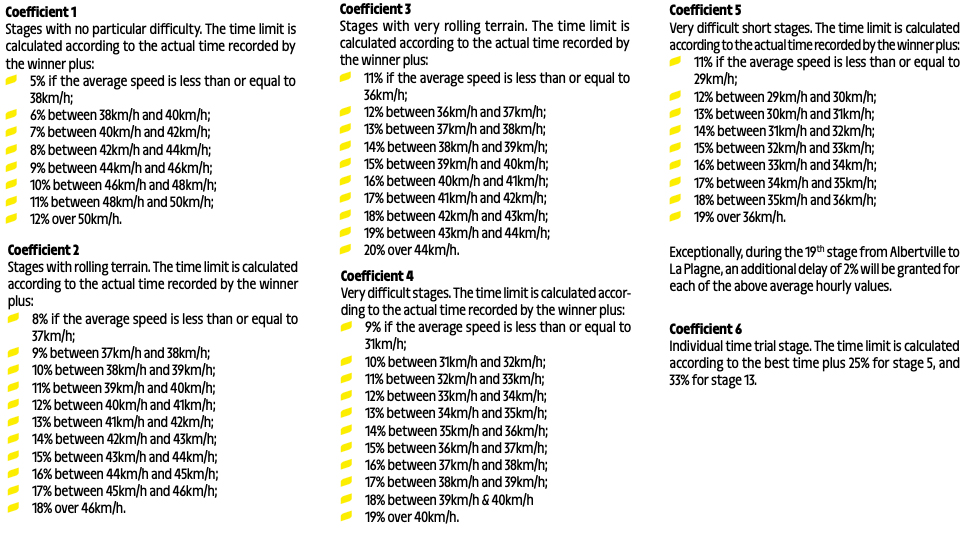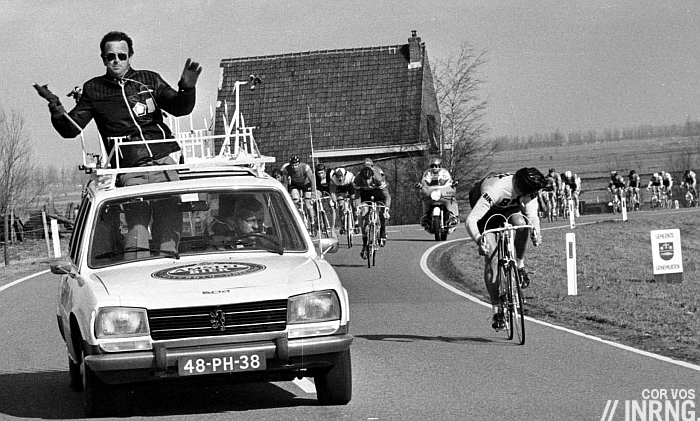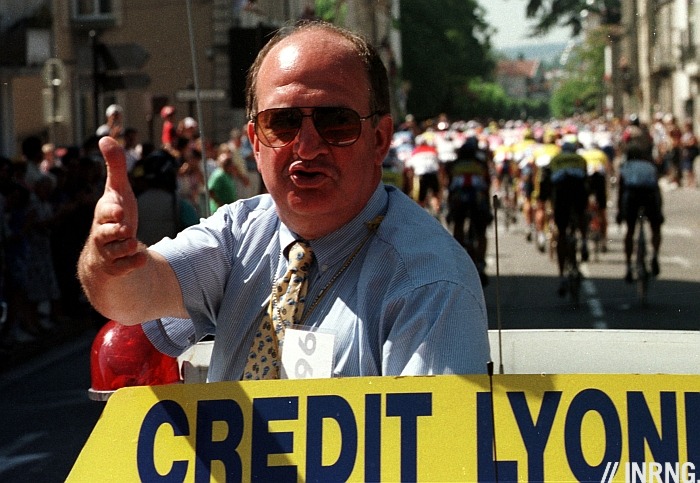There are a few changes to the rules this year which could be worth note at this year’s Tour which range from feeding to sprinting and the mountain stages. To save you a click you don’t have to read this today but it might a useful reference in the coming weeks…
Yellow cards and the expulsion risk
New for 2025 is UCI rule 2.12.003 bis that says commissaires can issue a yellow card “whenever the behaviour concerned is susceptible of causing a risk for safety” in World Tour and .Pro events. It can apply to all sorts of things, a sticky bottle or drafting a team car, dangerous riding or littering.
Crucially rule 2.12.007ter says if a rider gets two within 30 days then they are disqualified. Now it’s possible to do this twice in a one day race and get excluded; it’s just much more likely over the course of three weeks that it happens. It means anyone getting a yellow card finds a UCI-branded sword of Damocles just waiting to cut them out of the race.
As things stand – the UCI keeps a register – Nils Politt (UAE) and Paul Penhoët (Groupama-FDJ) got a yellow card at the Critérium du Dauphiné which will lapse after the Tour’s opening weekend.
For the anecdote the first suspension applied during the Vuelta Feminina when a moto driver for a photographer was chucked off the race after a second card, a serious penalty for a duo earning a living. And Oscar Riesebeek became the first rider after two cards in the Tour of Belgium last month.

Sprinting

For the start of the year, the UCI banned riders sitting up to celebrate their team mate’s sprint win (rule 2.12.007.5.2). This looked a bit killjoy because it wasn’t the cause of many accidents; but riders sprinting for the lesser positions and precious points had complained this was getting in the way.
Now UCI quietly rewrote the rules of sprinting last month with stipulation that riders should not obstruct others during the sprint. The previous iteration of the rule was always subjective, it’s hard to define in text what bad sprinting is, it’s more something you know when you see it and it is applied with a partial view on the outcome, drift and it might be tolerated but do it and provoke an accident and a yellow card is likely to be brandished. So with this comes the potential for controversial judgements and the new obstruction element.

Feeding
Once upon a time riders got food and drink either from dedicated feed zones or would go back to fetch supplies from a team car. Because of the Coronavirus pandemic and sanitation rules it was agreed to let teams post staff and points of their choosing along the way rather than congregate. This created inequities though.
Matteo Jorgenson talked about last year’s Tour where on the Stage to Le Lioran his Visma-LAB team may have had 20 points staffed alongside the road to hand up bidons and gels while he met his old team mates at Movistar who only had five. Maybe it was 18 versus 7, it’s from a podcast last year and rather than find the exact quote point is big teams with resources had real advantage on long stages, not only to supply the riders regularly to the point where the could save 500-600g by only needing one bidon at a time, while their employers were able to afford the vehicles needed and added hotel bills for staff outside the usual team package.
This is now changed with rule 2.3.025 specifying hand-ups can only occur at dedicated points along the route, like the feedzones of old but rather than one or two per stage they should be every 30-40km, with some flexibility to ensure they’re not on a descent or some other inappropriate place.
Also the old version had a further rich-get-richer scenario as explained last year where Visma-LAB were selling travel packages and then giving participants the chance to hand up bidons, so rather than paying for extra help in effect they were making money here. Now though helpers have to be UCI-licence holders which is still possible – you can become a member of your national federation – but it makes it less haphazard.
With fewer points it means the old role of having to go back to the team car to fetch supplies should be more visible again.
Time Cuts

Those are the time cuts for 2025, if you want to know which stages have which coefficients then inrng.com/tour has you covered. But the difference is an added percentage point. What read 4% for a Coefficient 1 stage ridden at <38km/h now has 5%; a short mountain stage that was blitzed at >36km/h had an 18% cut and this now goes to 19%.
The Tour is tight, for comparison a Giro mountain stage is 21% for 30-34km/h. But this gives riders a bit of slack, potentially a sop to the sprinters who have fewer stages and no more the allure of flat finish in Paris.
Time bonuses
Loyal readers will have read it before but there no more “B” special time bonus sprints this year and the intermediate sprints don’t offer time either. It’s 10-6-4 seconds at the finish line only.

Commissaires
Finally a mention of the commissaires. The UCI writes some rules but while the time cuts are set by the organisers ASO. But the commissaires, or jury as they’re sometimes called, are UCI officials implement them. This year’s head of the jury at the Tour is Gianluca Crocetti from Italy who has done the role before.
They’re all volunteers too, amateurs in the noble sense giving up their time to officiate. They a hotel bed for the night, travel expenses, a UCI uniform of a light blue shirt and beige chinos, plus and a daily rate of €160. Crocetti works most of the year as an insurance agent, and using up weekends and his holiday allowance to officiate. It’s one way to see France.
Conclusion
The feeding rules aren’t new in time for the Tour but will have an impact, especially if it is very hot. The obstruction rule tweak opens up the chance of more yellow cards. Even just one yellow card is a news story, think of the sprinter who gets one this weekend and how they’ll be at risk for the next sprint, or imagine if Pogačar drops some litter during a stage this weekend and the consequences hanging over him. If the sprinters are at risk because of one rule change, the slight easing to the time cuts is a small comfort at least.


Very dutch looking road in that last B&W photo. Plus… dutch reg, and… hard to be sure, but “Amstel” logo on bonnet?
It is definitely “bier”.
The sign to the right looks bilingual. So Belgium?🇧🇪
Yes, Amstel Bier sign, the sign on the right says “Gemente” on top and a name that I can’t quite make out on the bottom.
Genemuiden, too north for the Amstel?
The lack of leaves on the trees (even in the far distance) suggests it isn’t late April, but a bit earlier in the year.
Could well be Genemuiden. Those flat land behind look very much like polders, with the road a bit higher than them. If it’s Gemeente Genemuiden, then this surely must be the Kamperzeedijk weg from Genemuiden to Grafhorst – cause that seems to be the only wide road in the Gemeente that is bendy. Every other road is either straight and/or much narrower. I can’t find this corner and this building though. Maybe the building is gone though. Lot of the buildings look fairly new (new build to old style).
The yellow card issue will no doubt cause a controversy or two. Probably teams calling for a rider on another team should get one, will rise it’s ugly head. This is a professional sport after all.
So we wont get a repeat of Froome’s ride to glory in the Giro, when guys and gals were spread out along the parcours.
The obstruction rule is something that many fans and commenters have assumed to be there for years and based their judgements on who should and should not be penalised accordingly.
If it is applied consistently in every mass sprint then the number of penalties would be huge – outside of a very dominant train and everybody else in line behind them, sprints where the number of riders sprinting is in double figures on an 8m wide finishing straight [always assuming that the finish is straight which, of course, it all too frequently isn’t] and nobody switches position in looking for an opening or some extra draft and doesn’t obstruct anyone else will be vanishingly few and far between. Messy sprints are messy. They are also messy for understandable reasons which are unlikely to go away when scheduling flat cycling races contested by 20+ teams, the majority of whom have a reason to be invested at the finish.
As such, the rule is unenforceable and it will be applied, has to be applied, selectively. There will be unfairness and inconsistency. More riders will throw their hands up in the air in the final metres, appealing publicly to both the jury and social media for redress, specially as that has been seen to work often over the last year or so since the yellow card system was introduced. Football took some time before it acted on the tactic of telling the referee to card opposition players. I think cycling has some way to go before getting to that realisation of ‘be careful what you wish for’.
Was Dan McLay’s meandering sprint to win in Denain all those years ago the most amazing sprint ever or deviation from his sprinting line and thus a crime worthy of relegation if not disqualification?
It’ll be “interesting” to see the interpretation as the rule was changed in June and so there’s not much time for officials and riders alike to establish the boundaries.
I’m guessing I either misheard, misunderstood or imagined it, but I thought a team couldn’t have yellow jerseys this year(?)
The idea is to coordinate better so that teams don’t have clashing kit with the leader’s jersey, it’s something that’s been done before but the rules got tweaked last year.
I,m not worried about yellow cards being applied “consistently”. Such a thing is impossible and is always in the eye of the beholder and everyone has a different eye. As long as the card system has riders moderating their behavior because they may get a card then it has done its job. The same as any sport with suspensions and penalties.
The one rule i would like to be applied to sprinting is that if a support rider gets relegated the sprinter should to. A couple of years ago a lead out rider got relegated and the sprinter won. Not exactly a penalty the team cried over.
Yes, applying the rule that way (allowing the win to stand) gives a decent incentive to a crafty lead-out rider to ‘take the hit’ while making sure his sprinter wins.
Regarding the yellow card system, to me the beauty of the yellow card system isn’t that it will be foolproof and applied absolutely consistently. It won’t be and can’t be. It’s that there is now a meaningful intermediate penalty between relegation/DQ and nothing.
One thing we saw at the Giro is the ability to appeal. One of the EF riders got a card but it was removed later, so it might take two clear cases to expel a rider. All the same, it can be two kamikaze switches in the sprint causing a crash… or twice blatant littering.
Yeah, the ability to appeal is useful and seems the fair thing to do. What I’m primarily getting at regarding yellow cards as ‘intermediate’ penalties is that they can be applied even with a star rider does something stupid/dangerous but doesn’t cause a crash. In the past, stars often got away with things that others would be relegated for. We’ve seen that kind of double standard too many times.
One of the problems with inconsistency of application of a rule is that it can diminish the respect for the rule.
Diminished respect for the rule among those whose behaviour it is meant to moderate will mean that the behaviour is that much less likely to be moderated.
So there is an inherent problem with taking the position that inconsistency is not something to worry about while hoping – against all current evidence – that it will somehow change behaviour in the peloton.
Very interesting and meticulously researched, as ever.
Sorry to be pedantic, but there’s a typo:
…a potentially a sop to the sprinters